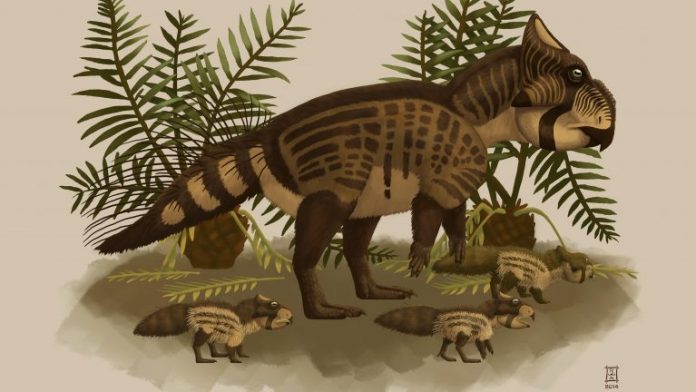Almost 50 years ago, a geologist working on a railroad in northern British Columbia noticed something unusual in the rocks: a mysterious claw. He had discovered one of the first skeletons of a dinosaur found in BC.
Now, after years of study by the Royal BC Museum’s curator of palaeontology, Dr. Victoria Arbour, the dinosaur has been recognized as an entirely new species of dinosaur, and the first dinosaur species unique to BC, named Ferrisaurus sustutensis.
Today, Dr. Arbour’s article, “A new leptoceratopsid dinosaur from Maastrichtian-aged deposits of the Sustut Basin, northern British Columbia, Canada”, was published on the peer-reviewed scientific journal PeerJ – the Journal of Life and Environmental Sciences. Her co-author is David Evans from the Royal Ontario Museum.
“Congratulations to Dr. Arbour for this historic discovery,” said Lisa Beare, Minister of Tourism, Arts and Culture. “This is an exciting scientific milestone for our province and I encourage everyone to come see the fossils for themselves at the Royal BC Museum.”
“Luck may have played a role in discovering this specimen, but it was only through thorough research that the world now recognizes this as a new species,” says Prof. Jack Lohman, CEO of the Royal BC Museum. “This spectacular news is yet another example of how the Royal BC Museum advances knowledge of the natural world through hard work in the collections and the field.”
Ferrisaurus sustutensis (pronounced “FAIR-uh-SAWR-us SUSS-tut-EN-siss”) means “the iron lizard from the Sustut River”, a reference to its discovery on the BC Rail line along the Sustut River. Before the peer-reviewed journal was published, Dr. Arbour had taken to referring to the dinosaur as “Buster”.
Ferrisaurus is a new species in a rare family of dinosaurs called Leptoceratopsidae: hornless, parrot-beaked plant-eaters closely related to the Triceratops. Ferrisaurus was about 1.75 metres long and probably weighed about 150 kg (330 lbs), similar in size to a bighorn sheep.
Buster’s bones are now in the Royal BC Museum’s paleontological collections. The skeleton is one of the first dinosaur fossils ever found in the province.
By studying Buster’s bones and other fossils from the same region, Dr. Arbour is learning what BC was like during the age of dinosaurs, 67 million years ago. In 2017, Dr. Arbour led an expedition to the Sustut River to relocate the site where Ferrisaurus was discovered in 1971, and found new fossils, including plants and part of a turtle, that are now part of the Royal BC Museum’s collection.
Because so much of this province is mountainous and forested, evidence of BC’s dinosaurs is challenging to find. Dr. Arbour will continue to search for dinosaur fossils in the high alpine plateaus of northern British Columbia next summer, during field work: annual research that many Royal BC Museum curatorial and collections staff members undertake throughout BC.
You can learn more about the story of “Buster” the Ferrisaurus in the Royal BC Museum’s Pocket Gallery display, “BC’s Mountain Dinosaur”, in the museum’s main floor—accessible to all visitors, free of charge—until February 26, 2020.















